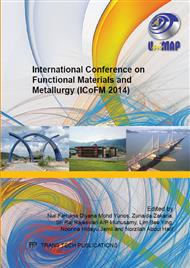[1]
T. Ngo, P. Mendis, A. Gupta, &J. Ramsay, Blast loading and blast effects on structures – an overview, Electronic Journal of Structural Engineering, Special Issue: Loading on Structures. (2007)76-91.
DOI: 10.56748/ejse.671
Google Scholar
[2]
C.C. Ng, S.H. Chew, G.P. Karunaratne, S.A. Tan S.L. Loh, Flexible and rigid faced mechanical stabilized earth walls subject to blasting. American Society of Civil Engineers. STP no. 103 (2000) 332–336.
DOI: 10.1061/40515(291)21
Google Scholar
[3]
Z.W. He, Geosynthetics reinforced structures subject to blast load, Ph. DThesis, National University of Singapore. (2009).
Google Scholar
[4]
K. Scherbatiuk&N. Rattanawangcharoen, A hybrid rigid-body rotation model with sliding for calculating the response of a temporary soil-filled wall subjected to blast loading. International Journal of Impact Engineering. 38 (2011).
DOI: 10.1016/j.ijimpeng.2011.02.002
Google Scholar
[5]
X.Q. Zhou&H. Hao, Prediction of air blast loads on structures behind a protective barrier. International Journal of Impact Engineering. 35 (2008) 363-375 doi: 10. 1016/j. ijimpeng. 2007. 03. 003.
DOI: 10.1016/j.ijimpeng.2007.03.003
Google Scholar
[6]
T. C. C. Chapman,T. A. Rose &P.D. Smith Reflected blast wave resultants behind cantilever walls: a newprediction technique. International Journal of Impact Engineering. 16(1995).
DOI: 10.1016/0734-743x(94)00051-w
Google Scholar
[7]
W.E. Baker, Explosions in Air. University of Texas Press, Austin, (1973).
Google Scholar
[8]
P.D. Smith J.G. Hetherington, Blast and Ballistic Loading of Structure. Butterworth-Heinemann Ltd., (1994).
Google Scholar
[9]
A. M. Remennikov, A review of methods for predicting bomb blast effects on buildings, Journal of BattlefieldTechnology. 3 (2003) 5–10.
Google Scholar
[10]
TM5-1300: Structures to Resist the Effects of Accidental Explosions U.S. Department of the Army Technical Manual. (1991).
Google Scholar
[11]
Century Dynamics. AUTODYN-2D & 3D version 6. 0 user documentation. (2005).
Google Scholar
[12]
T. H. W. Andy, Reinforced soil walls for mitigation of close range blast loading. Ph. D thesis. National University, Singapore. (2010).
Google Scholar
[13]
J. Jestin,A. Faisal,M. A. Z. Ahmad, F. S. K. Md, &Z. O. Mohd, : submitted to Modern Applied Science Journal (2014).
Google Scholar
[14]
J. B. David, Computational method in Lagrangian and EulerianHydrocodes. Computer Method in Applied Mechanics and Engineering. 99 (1992)235-394.
Google Scholar
[15]
N.K. Birnbaum, J. F. Nigel, &I. G. Bence, Coupled techniques for the simulation of fluid-structure and impact problem. Century Dynamic Inc. 2003. http: /hsrlab. gatechedu/AUTODYN/papers/paper63. pdf. Retrieve 30 Oct (2012).
Google Scholar
[16]
L. Laine&A. Sandvik, Derivation of mechanical properties for sand, Proceedings of 4th Asia-Pacific Conference on Shock & Impact Loads On Structures, Singapore. CI-Premier Ltd., (2001)361 -368.
Google Scholar
[17]
S. C. K. Yuen, G. S. Langdon, G.N. Nurick& E.G. Pickering, Response of v shape plates to localised blast load: experiment and numerical simulation. International Journal of Impact Engineering. 46(2012).
DOI: 10.1016/j.ijimpeng.2012.02.007
Google Scholar


